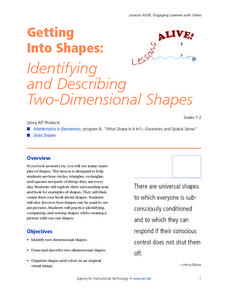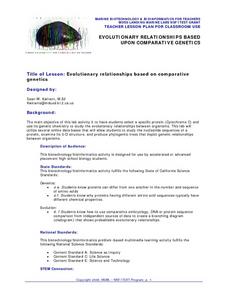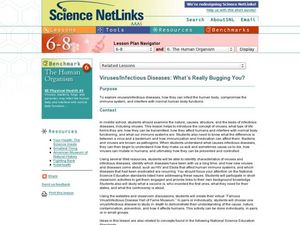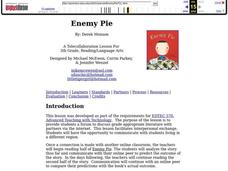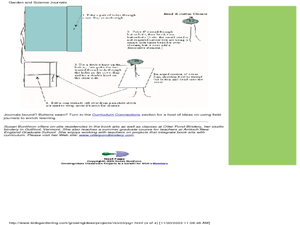Curated OER
Problem Solving? Cereal
Young scholars use problem-solving approaches to investigate mathematical content. They formulate problems from situations within and outside mathematics content. They warm up with a survey done by the teacher. Everyone uses practice...
Curated OER
Radio Program #7: The Impact of Early Radio
Students examine and interpret the experiences of persons who lived in the early days of radio. identify the technology, program content, and social aspects of early radio listeners. They interview parents for their experiences. Students...
Curated OER
Getting Into Shapes: Identifying and Describing Two-Dimensional Shapes
Young scholars examine their classroom to find examples of various types of shapes. After identifying and describing the various shapes, they draw as many as they can on a piece of paper. They organize them into an image based on their...
Curated OER
Evolutionary Relationships Based Upon Comparative Genetics
High schoolers investigate the protein cytochrome c in an attempt to use its genetic chemistry to study possible evolutionary relationships between organisms. The lesson integrates technology with the use computers to perform DNA analysis.
Curated OER
Catalase: A Bioinformatics Case Study
Students investigate the physical structure of a protein by using a computer simulation tool. They record its primary amino acid structure while viewing it in three dimensions for a better visual recognition. There is also a comparison...
Curated OER
The National Math Trail
Students explore the many applications of mathematics in their environment . They formulate and solve mathematics problems. Students describe geometric elements, shapes and relationships. Students use technology such as digital cameras...
Curated OER
Viruses/Infectious Diseases: What's Really Bugging You?
Middle school life science or health classes listen to an audio, visit websites, read different articles, and participate in a class-wide simulation about the spread of viruses. The lesson doesn't get into the mechanics of how viruses...
Curated OER
Controlling the Pandemic: Public Health Focus
Students examine global issues centered around HIV and AIDS. In this health science lesson, students compare and analyze public health measures and factors that affect the treatment of HIV/AIDS. They examine the role of socioeconomic...
Curated OER
European Integration: Who and Why?
This French IV-V lesson addresses European integration into the European Union. French language learners research, discuss, and present in the target language. Online research, discussion, and presentations will take approximately 5-7...
Curated OER
The Star-Spangled Banner
Get your kids moving as they learn about the history of the United States National Anthem. Scholars examine the War of 1812, Francis Scott Key, and the meaning behind The Star Spangled Banner as they listen to an 18-minute...
Curated OER
Making Inferences While Identifying Similes and Metaphors
Use this lesson to study similes and metaphors and the inferred meaning. In this language arts lesson, 5th graders write their own similes and metaphors. A worksheet is provided for extension work or to check understanding as homework.
Curated OER
Enemy Pie
Third graders pair up with a partner via an online classroom. They analyze half of the story "Enemy Pie" and communicate with their online peer to predict the outcome of the story.
Curated OER
Prairie Scavenger Hunt
Here is a simple lesson for young learners on the plants, animals, and flowers found in the prairie environment. There are worksheets embedded in the plan that pupils use once a teacher-led discussion and demonstration has taken place....
Curated OER
Surviving the Winter
Fifth graders investigate given cultures using the internet, personal interviews and other sources, They examine how the civilizations of six Native American tribes and six Australian Aboriginal tribes survived during their respective...
Scholastic
Descriptive Writing Fortunes
What does your fortune say? Engage class members in writing complete sentences by first handing out fortune cookies and reading the messages. Pupils will practice writing complete sentences by composing fortunes to put in die cut fortune...
Curated OER
Making Field Journals
Students follow a bookmaking format to create a book and use it as a garden journal. In this science journal instructional activity, students follow book making directions to create a garden and science journal.
Curated OER
And the Survey Says...
Create a survey and graph! For this graphing lesson, students listen to a story about pets, create a survey for family and friends about what pets they own, and use the information to create a bar and line graph.
Edgate
Why Map a Map?
After brainstorming reasons why Native Americans mapped their lands, your young critical thinkers will work together to review their ideas and determine the definition of a map. With today's extensive use of mapping technology and GPS...
Curated OER
Taxes and Social Security
Students practice filling out the United States Federal 1040EZ tax form and share examples in a class discussion. A written exam is provided to help assess cumulative comprehension.
Curated OER
Data With Candy
Students, while utilizing the classroom and the computer lab with a bag of colored candy, gather and interpret data, calculate averages and draw conclusions and draw a bar graph. They estimate how many candies are in the bag, what...
Curated OER
What Can I Afford?
Middle schoolers explore the concept of cell phone plans. In this cell phone plan lesson, students research the cost of cell phones. Middle schoolers compare various cell phone plans and decide on which phone plan is best for them.
Curated OER
Have You Looked Outside? Lesson #5- Graphing Weather Conditions
First graders study daily weather changes. In this weather and graphing lesson, 1st graders chart the daily weather for a month using stickers or weather symbols. They graph the weekly weather so that at the end of the month students...
Curated OER
Cover Your Mouth Please!
Second graders investigate how to slow the spread of germs from coughing and sneezing. In this illness prevention lesson, 2nd graders talk about why people cough and sneeze before telling about ways to prevent the spread of germs. They...
Appalachian State University
Making Your Point Using Dialect
Explore the sounds, importance, and effectiveness of dialect in literature. Active participants read, listen to poetry, and explore dialect by developing a formal definition, discuss the benefits of its use, complete a Venn diagram...


